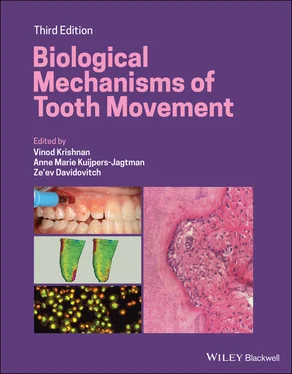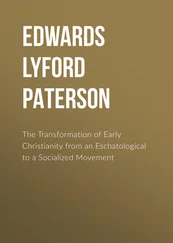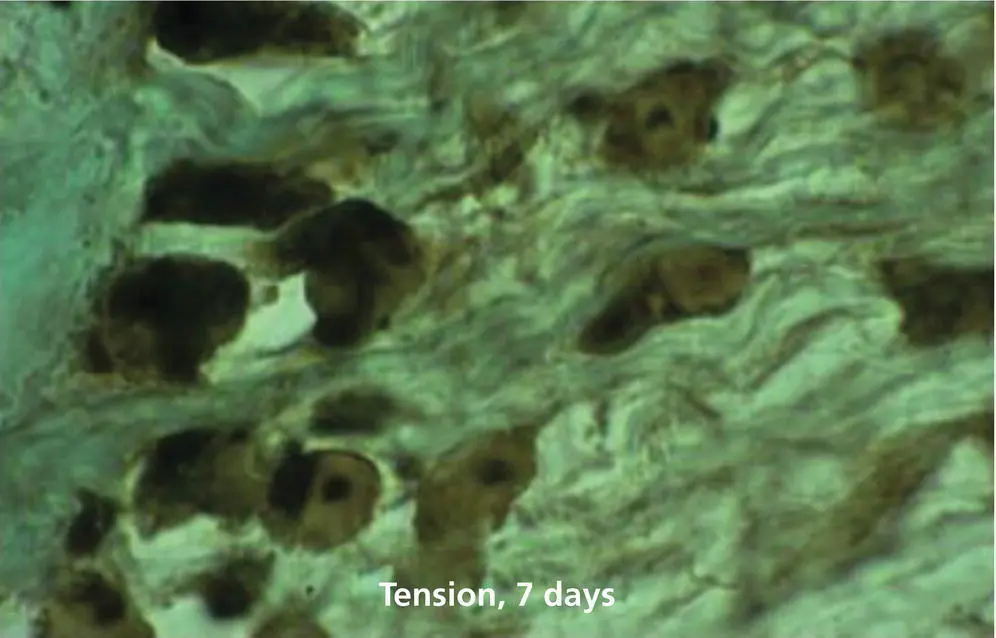
Figure 1.20 Staining for cyclic AMP in the tension zone of the PDL after 7 days of treatment. The active osteoblasts are predominantly round, while the adjacent PDL cells are elongated. All cells are intensely stained for cAMP.
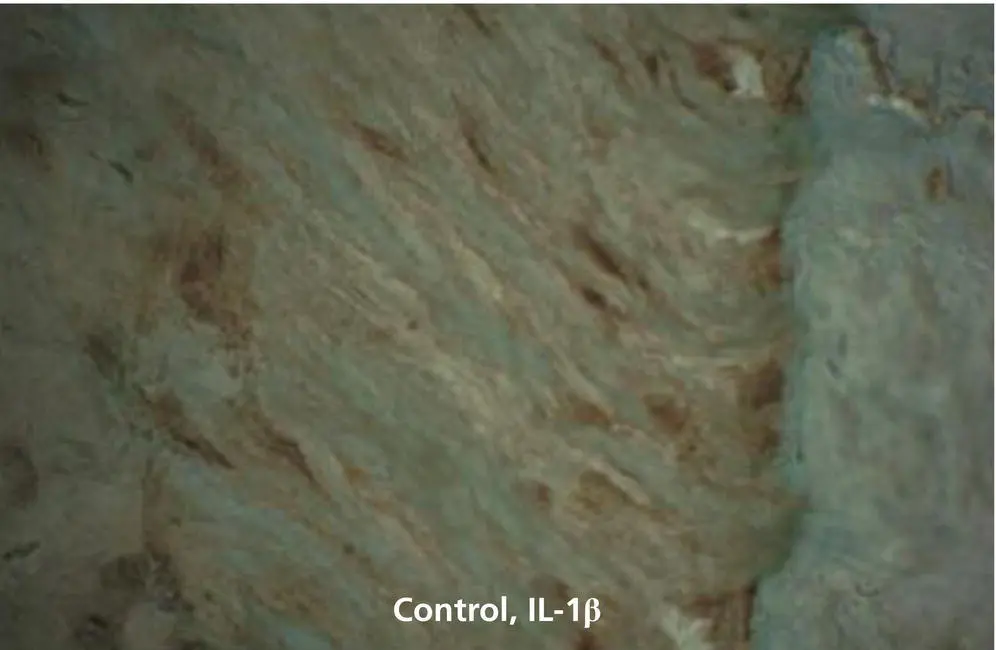
Figure 1.21 Immunohistochemical staining for IL‐1β in PDL and alveolar bone cells near a cat maxillary canine untreated by orthodontic forces (control). The PDL and alveolar bone surface cells are stained lightly for IL‐1β.
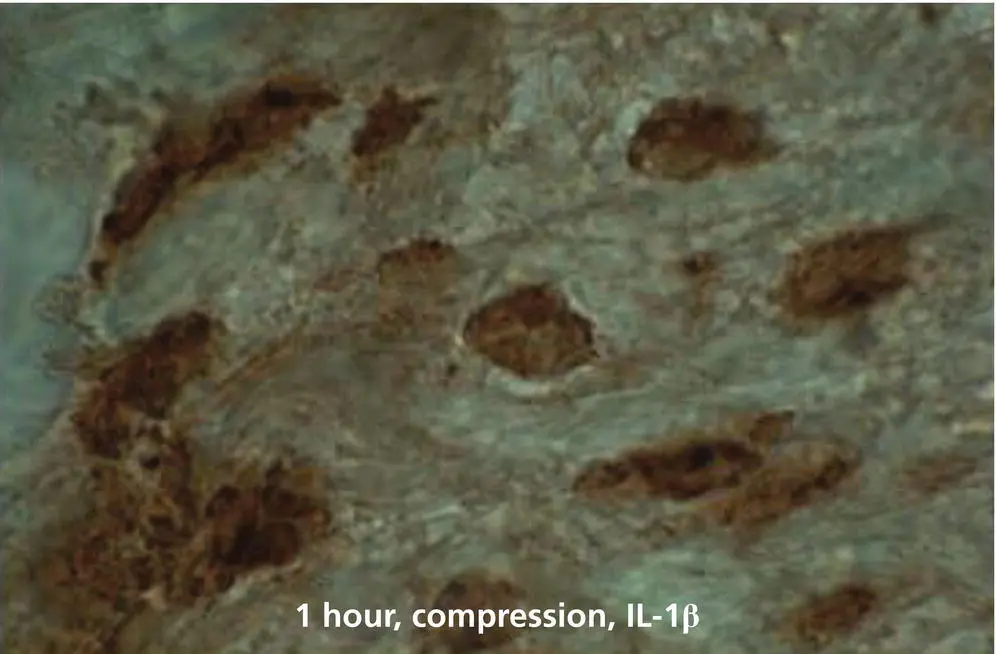
Figure 1.22 Staining for IL‐1β in PDL and alveolar bone surface cells after 1 hour of compression resulting from the application of an 80 g distalizing force to the antimere of the tooth shown in Figure 1.21. The cells stain intensely for IL‐1β in the PDL compression zone, and some have a round shape, perhaps signifying detachment from the extracellular matrix. × 840.
Efforts to identify specific molecules involved in tissue remodeling during OTM have unveiled numerous components of the cell nucleus, cytoplasm, and plasma membrane that seem to affect stimulus‐cell interactions. These interactions, as well as those between adjacent cells, seem to determine the nature and the extent of the cellular response to applied mechanical forces. The receptor activator of nuclear factor kappa B ligand (RANKL) and its decoy receptor, osteoprotegerin (OPG) were found to play important roles in the regulation of bone metabolism. Essentially, RANKL promotes osteoclastogenesis, while OPG inhibits this effect. The expression of RANKL and OPG in human PDL cells was measured by Zhang et al . (2004). The cells were cultured for 6 days in the presence or absence of vitamin D 3, a hormone that evokes bone resorption. The expression of mRNA for both molecules was assessed by RT‐PCR, while the level of secreted OPG in the culture medium was measured by ELISA. It was found that both molecules were expressed in PDL cells, and that vitamin D 3downregulated the expression of OPG and upregulated the expression of RANKL. These results suggest that these molecules play key roles in regulating bone metabolism. The response of human PDL and osteoblast‐like cells to incubation for 48 hours with PGE 2revealed that both cell types were stimulated to express RANKL, but that the bone cells were significantly more productive in this respect. When the cells were co‐cultured with osteoclast‐like cells, the osteoblasts evoked osteoclastogenesis significantly greater than the PDL cells (Mayahara et al ., 2012). Recent studies in this regard have confirmed the same in human volunteers (Otero et al., 2016) and were even able to establish a clear role between RANKL production and the root resorption process associated with OTM (Yamaguchi, 2009).
The abovementioned studies illuminate information on the biological aspects of OTM but many gaps still remain. Tooth movement is primarily a process dependent upon the reaction of cells to applied mechanical loads. It is by no means a simple response, but rather a complex reaction. Components of this reaction have been identified in experiments on isolated cells in vitro . However, in this environment the explanted cells are detached from the rest of the organism and are not exposed to signals prevailing in intact animals. In contrast, in orthodontic patients the same cell types are exposed to a plethora of signal molecules derived from endocrine glands, migratory immune cells, and ingested food and drugs. A review of pertinent literature published between 1953 and 2007 by Bartzela et al . (2010) revealed details on the effects and side‐effects of commonly used medications on tooth movement. Nonsteroidal anti‐inflammatory drugs and estrogen were found to decrease OTM, whereas corticosteroids, PTH, and thyroxin seem to accelerate it. However, the individual responses to these medications may differ significantly from patient to patient, and such differences may have profound effects on treatment duration and outcomes. This fact implies that an orthodontic diagnosis should include information about the overall biological status of each patient, not merely a description of the malocclusion and the adjacent craniofacial hard and soft tissues. Moreover, periodic assessments of specific biological signal molecules in body fluids, especially in the gingival crevicular fluid and saliva, may be useful for the prediction of the duration and outcome of orthodontic treatment. The ever‐growing flow of basic information into the orthodontic domain promotes the adoption of the concept of “personalized medicine” (Kornman and Duff, 2012). The main investigative tool in this regard is molecular genetics, which has been used successfully in oncology in the search for faulty genes, responsible for the initiation, growth, and dissemination of a variety of tumors. This approach is growing in significance in medicine and is beginning to occur in dentistry. Orthodontics, where genetics plays a major role in determining the morphology and physiology of the orofacial region, is a natural candidate to use this rapidly expanding body of basic information in order to formulate treatment plans that fit closely the biological features of each individual patient.
Conclusions and the road ahead
Orthodontics started with the use of a finger or a piece of wood to apply pressure to crowns of malposed teeth. The success of those manipulations proved convincingly that mechanical force is an effective means to correct malocclusions. Until the early years of the twentieth century, understanding the reasons why teeth move when subjected to mechanical forces was only a guess, based on reason and empirical clinical observations. Farrar hypothesized in 1888 that teeth are moved orthodontically due to resorption of the dental alveolar socket and/or bending of the alveolar bone. Both hypotheses were proven to be correct during the twentieth century, as orthodontic research has spread into increasingly fundamental levels of biological basic research. The rationale for these basic investigations was the wish to unveil the mechanism of translation of mechanical signals into biological/clinical responses; the etiology of iatrogenic effects resulting from OTM; and to discover efficient means to shorten significantly the duration of OTM. Many details on the behavior of cells involved in OTM have emerged from those investigations but, despite this progress, the final answer to the above issues remains elusive.
At present, molecular biology and molecular genetics remain at the cutting edge of orthodontic research. Multiple genes that may be involved in the cellular response to mechanical loads have been identified (Reyna et al., 2006), and genes associated with orthodontic‐induced root resorption (Abass and Hartsfield, 2006). The role played by specific genes in OTM was revealed by Kanzaki et al . (2004), who reported that a transfer of an OPG gene into the PDL in rats inhibits OTM by inhibiting RANKL‐mediated osteoclastogenesis. According to Franceschi (2005), future efforts in dental research will include genetic engineering, focusing on bone regeneration. Recently, Zhao et al . (2012), through experiments in male Wistar rats, reported inhibition of relapse with local OPG gene transfer through the inhibition of osteoclastogenesis.
Читать дальше
